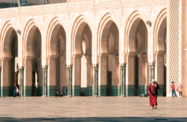Morocco: Feeling pressure from Europe
 En Français
En Français
Spill over from the eurozone crisis, combined with muted foreign visitor arrival numbers and a slump in agricultural output, have greatly impacted Morocco’s economic performance in the first half of 2012, with challenges still to come for the remainder of the year.
A glance at some select economic indicators shows the difficulties the economy is facing. According to its June statement, Bank Al-Maghrib, the central bank, reported, “Preliminary data shows that the trade deficit has widened further as of the end of May 2012. Meanwhile, transfers of Moroccans living abroad slowed down from 8.2% to 2% year-on-year, and travel receipts fell 0.2% after rising 13% by the end of May 2011.”
In mid-June Bank Al-Maghrib kept its benchmark lending rate at 3%, the same level it has held since March, when the lending rate was cut by 25 basis points from 3.25% to 3%. Until this recent rate cut, the central bank had left interest rates unchanged for three years.
In a March statement, the central bank explained, “In the context where economic activity has declined significantly… and the balance of risks is skewed to the downside, the board decided to reduce the key rate”. The bank currently describes the balance of risks as “broadly neutral”.
The muted performance of the broader economy can be seen in the figures posted by some of the more prominent GDP contributors. Tourism, for example, which is a key sector for Morocco, has seen its own difficulties recently as well. As the North African kingdom relies on mainland Europe for almost 70% of its visitors – France and Spain top the list of foreign tourists, followed by the UK, Germany and Belgium– the current belt-tightening among many European households has led to a decrease in visitor numbers.
Indeed, tourist arrivals dropped over the first three months of 2012, compared to the same period in 2011: the Ministry of Tourism (Ministere du Tourisme et de L’Artisanat) reported a 9% decrease in January 2012 compared to the same month last year and a 5% decrease in February 2012 compared to February 2011.
This need not be as concerning as it might appear. Visitor arrivals had slowed last year as well, due to the complications from the eurozone debt crisis and broader uncertainty engendered by the Arab Spring, although Morocco still managed to increase overall tourism revenues nonetheless. Furthermore, the rate of decline slowed in March, with arrivals down just 1% over the same month the previous year.
However, net foreign direct investment, which has traditionally favoured the tourism and real estate sectors, was also down by 11.8%, according to the central bank, though it did not provide any details on what investment did come in and where it was directed.
Morocco is particularly vulnerable to Europe’s slowdown because the EU is its biggest trading partner and tourism its largest source of foreign currency. Tourism’s direct contribution to the economy was estimated at Dh71.8bn (€6.5bn), or 8.9% of GDP, in 2011, according to the World Travel & Tourism Council (WTTC).
Its total direct and indirect contribution, however, was estimated to be Dh152.5bn (€13.8bn), some 19% of GDP. The sector is also the second-largest industry in terms of jobs, employing 834,500 Moroccans, accounting for 7.8% of total employment.
The Arab Spring protests throughout the Middle East not only saw a decline in tourist numbers, but also led to the government responding by raising public sector wages and trebling funds to food and energy subsidies to over $6bn. As a result, the budget deficit is expected to account for 5% of GDP by the end of 2012, according to Abdellatif Jouahri, the governor of the Bank Al-Maghrib.
Exogenous factors have impacted other major sectors as well. The government has had to contend with drought, which will continue to affect food prices in the near term. Agriculture is a significant contributor to the economy, accounting for an average of 13.4% of GDP between 2006 and 2010. A report from the USDA Foreign Agricultural Service stated in mid-March that Morocco’s cereal production is in a “precarious” state.
A lack of rainfall, which delayed the sowing of grain, and abnormal cold spells have hampered crop development. As a result, cereals production is expected to reach only 4m tonnes in 2012, half of last year’s harvest.
Given the external difficulties the economy continues to face, economic growth projections remain conservative. The central bank expects growth this year to remain at less than 3% for overall GDP and between 3% and 4% for non-agricultural GDP. This is down from the 4-5% growth the IMF estimated the country would see in 2012.
Inflation is expected to average around 1.4% this year. “The average inflation forecast for 2012 was revised down from 1.7% to 1.4%,” said the Bank Al-Maghrib. The inflation rate, which reached 1.2% in April, was mainly driven by “higher volatile food prices”.



